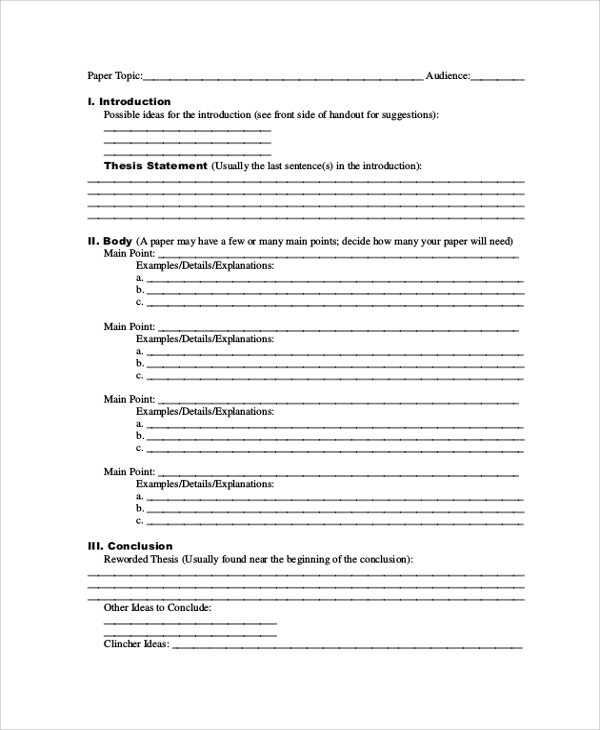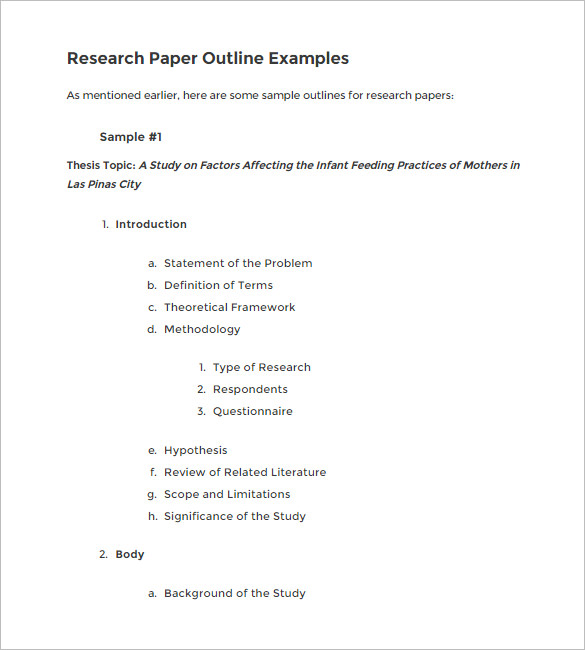
· Follow these steps to start your research paper outline: Decide on the subject of the paper Write down all the ideas you want to include or discuss Organize related ideas into sub-groups Arrange your ideas into a hierarchy — what should the reader learn An outline is an ordered list of the topics covered in a research paper. It is useful to both writer and reader. The writer who writes from an outline is less likely to stray from the point or to commit a structural error—overdeveloping one topic while skimping on another, for example · It is called a working outline for two reasons; first, it is a "sketch" or initial plan for your paper and it is flexible and can change as you research and learn more about your topic. A working outline often begins with the thesis statement
A Step by Step Guide to Write A Research Paper Outline
By the time you have created an effective formal outline, you will be ready to write a first draft of your paper. Indeed, many writers work from rough, skeletal outlines to create first, exploratory drafts, and only then, after revising those drafts, do they commit themselves to a formal outline.
Note, too, that some writers do not find the need to use a formal outline; by the time they have created a first draft from their initial, organizational skeleton, they are ready to stick with that draft, revising working outline for research paper fine-tuning it, until they feel they have accomplished their purpose. Home Writing a Research Paper: Creating a Working Outline. Below is a generalized model working outline for research paper a research paper outline: Thesis Introduction Definition, Description, and History as appropriate Statement of Purpose Information Sources including research methods and materials Working Definitions if appropriate Limitations of the Report if appropriate Scope of Coverage sequence of major topics in the body Body First Major Topic First subtopic of A Second subtopic of A First subtopic of 2 Second subtopic of 2 And so on - subdivision carried as far as necessary Second Major Topic and so on Conclusion where everything is tied together A good outline also conforms to the following guidelines: It obeys the "rule of two" : each main topic should contain at least two subtopics; subtopics, if followed by sub-subtopics, working outline for research paper, should again contain at least two.
It avoids overlap: each topic addresses a distinct idea. It maintains coherence: subtopics and sub-subtopics relate directly to their major topics, rather than leading reader and writer off on tempting tangents.
It maintains internal parallelism : all items at any given level are grammatically-similar It provides clear and informative headings By the time you have created an effective formal outline, you will be ready to write a first draft of your paper. Examples of completed effective formal outlines: linguistics. Contact Writing Centre Elizabeth Ave, St.
John's, NL, CANADA, working outline for research paper, A1B 3X9 Postal Address: P. BoxSt. John's, NL, CANADA, A1C 5S7 Tel:
How to Outline Your Scientific Research Paper
, time: 9:57What is a working outline? How do I create one? - Answers

1. Begin with your thesis statement. It’s important to start your research paper outline with your thesis statement, or at least a topic sentence that supports your thesis statement. So when a person reads your outline, they can immediately identify what your research paper is all about. 2. List down the major points of your research paper For research papers, an outline may help you keep track of large amounts of information. For creative writing, an outline may help organize the various plot threads and help keep track of character traits. Many people find that organizing an oral report or presentation in outline form helps them speak more effectively in front of a crowd Before writing an research paper outline: Select an appropriate topic. Selecting a topic is a crucial factor for a successful research paper. Whether you select a State your argument. After selecting a topic, take some time to figure out what kind of argument you want to support. Define the
No comments:
Post a Comment